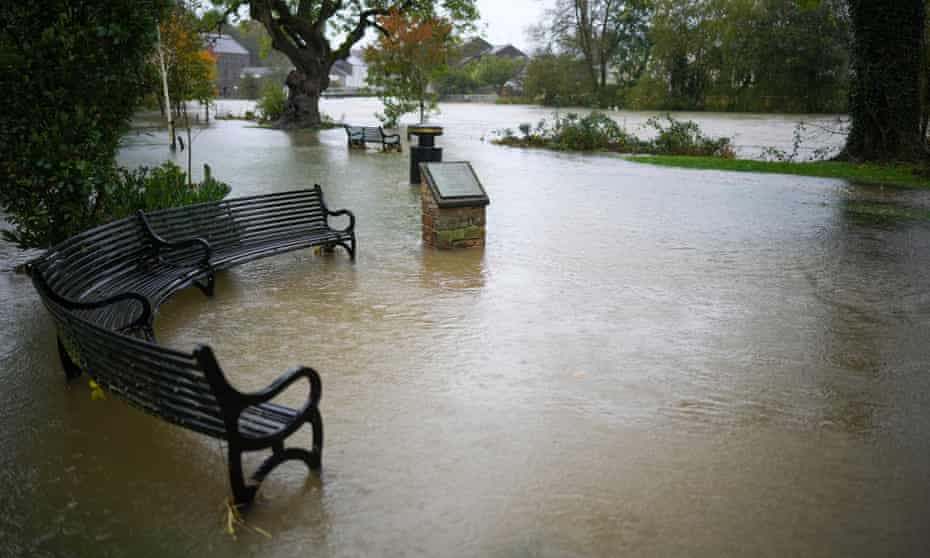Revealed: a third of England’s vital flood defences are in private hands
Some defences are at risk of failure but private owners cannot be forced to make upgrades

Last modified on Mon 1 Nov 2021 00.37 EDT
A third of England’s most important flood defences are in private hands, an investigation has found, with more than 1,000 found to be in a poor state and some at risk of “complete performance failure”.
Private owners cannot be forced to make upgrades to the defences, which can involve bills of hundreds of thousands of pounds. The government admits it can only “encourage” third-party owners to do maintenance, though the Environment Agency can carry out emergency repairs if there is a risk to people, property or environment, and try to bill the freeholders afterwards.
Data obtained under freedom of information laws by Unearthed, the investigative arm of Greenpeace UK, and shared with the Guardian, show that privately owned assets classed as “high consequence” are twice as likely to be in a poor condition as those maintained by the Environment Agency, with 8% or 1,109 of private defences rated as sub-par.
The defences range from flood walls or embankments to weirs and piers, though many are outfall pipes or culverts – enclosed watercourses that run underneath roads, railways or other property.
Some are owned by major landowners such as the crown estate or Network Rail. Others run under private houses and businesses, often unnoticed until something goes wrong. In 2014 a father and son in Waterlooville, Hampshire, were faced with a GBP150,000 bill to repair a culvert that went underneath their properties.
High-consequence flood defences are the most important because they “contribute to managing flood risk in a location where the consequence on people and property of an asset failing is high”, according to the Environment Agency.
Defences are inspected and then rated from condition 1 to 5, with 1 meaning “very good”. Four is “poor”, with “defects that would significantly reduce the performance of the asset”, and 5 is “very poor” – “severe defects resulting in complete performance failure”.
There is no public record of who owns or maintains private flood defences in England, and local authorities are often unaware. To build a partial picture of private ownership, Unearthed took Environment Agency data and overlaid it with data from the Land Registry and other sources.
Kirklees council in West Yorkshire, which dealt with bad flooding during Storm Ciara in 2020, said it did not know who owned the 23 privately owned defences in its area that were rated as poor or very poor. The local authority in Carlisle, which has seen repeated flooding in recent years, said the same about the 30 poorly rated private defences in the city.
Even when local authorities do know the owners, they cannot compel them to carry out repairs. “All we can do is ask nicely,” said James Mead, a flood and water manager at Sheffield city council, who said he contacted private owners by looking on Google Maps and cross-referencing with Environment Agency data.
Some 29 defences rated poor or very poor across England are on land owned by the crown estate, the Queen’s property manager. A spokesperson said the estate did not own the defences nor did it have responsibility for their upkeep, but did not respond when asked who was responsible.
“Where flood defences have been installed by third parties on crown estate land we will always work with the relevant authorities to offer any assistance we can to ensure they are able to access and maintain as required,” the spokesperson said.
Last year the National Audit Office said the Environment Agency’s plan to beef up England’s flood defences was being undermined by a lack of coordination between the various bodies tasked with maintaining them.
With increased flooding one of the greatest risks facing the UK as a result of the climate crisis, this year the government announced GBP5.2bn to build 2,000 new flood and coastal risk management schemes. Private defence owners will not be eligible to receive any of this money.
The Environment Agency estimates that 5.2m homes and businesses in England are at risk of flooding and that about 700 properties are vulnerable to coastal erosion over the next 20 years.
An Environment Agency spokesperson said: “We routinely inspect both Environment Agency and third-party flood assets. Repairs are prioritised where there is threat to lives and livelihoods. We work closely with third party asset owners to encourage them to undertake repairs.
“Since 2015, more than 300,000 homes have been better protected from flooding on time and on budget. We’ve also made extensive preparations for the winter months, with thousands of frontline staff ready to respond to a flooding incident should it occur.”
Olivia Blake, the shadow flooding minister, said the government must do more to make sure private defences are up to scratch. “As our winters get wetter, the climate emergency will put flood defences under greater strain,” she said. “The government must act to ensure there are clear responsibilities and adequate measures in place so that any flood defences which are privately owned and critically important to the protection of the public are properly inspected and maintained.”